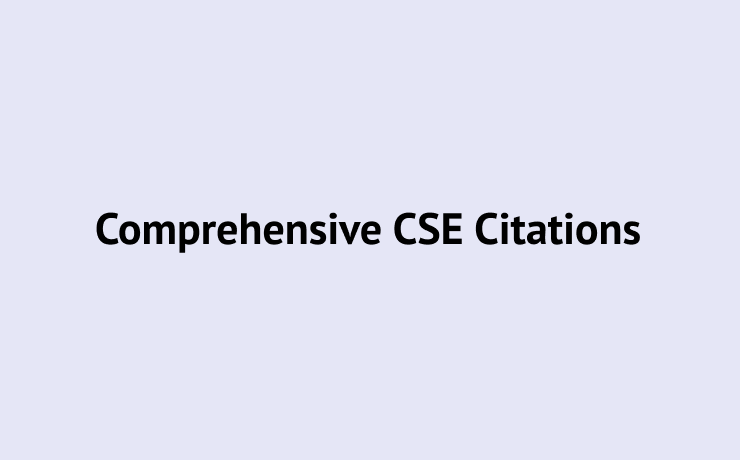Free CSE Citation Generator by AHelp
Simplified and Fast CSE Referencing Machine

Quick and Easy Citations
Create a CSE citation for any sort of academic paper with a simple-to-use interface of our generator. It doesn’t matter whether an article has several authors or a book has only one chapter relevant to your work – AHelp can handle it all.
Cite Electronic and Paper Sources
Leave all of the intricacies of citing both written resources and those entirely on the web to our tool. Every last comma will be remembered even when referencing documents in PDF, HTML, and text formats!
Three CSE Systems
Cover all three CSE citation systems in your academic writing, including citation-name, citation-sequence, and name-year. Just pick one and let us do the rest.Streamlining Scientific Documentation for Precision and Clarity

CSE Citation Generator
The Council of Science Editors (CSE) citation style, formerly known as the Council of Biology Editors (CBE) style, originated in the 1960s. It was developed to serve the specific needs of the scientific community, particularly in the fields of biology and other natural sciences. The CSE style is widely used by scholars and researchers in various scientific disciplines, including biology, ecology, zoology, and medicine.
The CSE citation style is unique for its flexibility, offering three distinct systems for citing sources: the Citation-Sequence system, the Citation-Name system, and the Name-Year system. Each system caters to different preferences and publication requirements. The Citation-Sequence system numbers references in the order they appear in the text. The Citation-Name system lists references alphabetically and then cites them in the text by number. The Name-Year system, similar to APA and MLA styles, cites sources in the text by the author’s last name and the year of publication, with a complete reference list at the end of the document.
How to Cite in CSE Style
In CSE style, creating a reference list involves specific formatting rules. Journal titles should be abbreviated without using periods (e.g., “J Exp Biol”). Author names are given in initials without periods (e.g., “Smith JN, Doe JR”) and the last author is separated from the others by a comma, not by “and” or “&”. References are formatted with a hanging indent, where the first line is at the margin and subsequent lines are indented.
CSE style offers three systems for in-text citations:
Citation-Name. This system uses superscript numerals for in-text citations. These numerals correspond to an alphabetized reference list at the end of the document, where each numeral is linked to a specific reference.
Citation-Sequence. Similar to Citation-Name, this system also uses superscript numerals in the text. However, the reference list is ordered not alphabetically, but sequentially according to how the sources appear in the text. The first source cited gets the numeral 1, the second source cited gets the numeral 2, and so on.
Name-Year. This system employs parenthetical in-text citations that include the author’s last name and the year of publication (e.g., “Smith 2020”). The corresponding reference list is organized alphabetically by the author’s last names.
Each of these systems is designed to maintain clarity and consistency in scientific writing, allowing the reader to easily locate and refer to the sources used.
How to Use AHelp Citation Generator for CSE In-Text Citations
The AHelp citation generator in CSE was designed to make the process of academic writing much easier. There is no need to stare at your screen and procrastinate about that pending deadline just because you don’t want to dive into the references. All you have to do to get the needed reference is to select your style of choice (in this case, it is CSE), gather all relevant information about the source, and put it into the citation generator. After mere moments you will have a ready-to-go reference that can be used in your work.
CSE Reference Page Citations
Creating a reference list in CSE style involves compiling full bibliographic details for all sources cited in your text. This list appears at the end of your paper and is organized alphabetically by the last name of the first author of each source.
For each entry in the reference list, the information to be included varies slightly depending on the type of source. For books and other monographs, you should list the author(s) or editor(s) first, followed by the year of publication, the full title, content or medium designator (like [Online] or [DVD]), edition if it’s not the first, secondary author(s) such as translators or editors, the place of publication, the publisher, pagination (total number of pages), and the series name, if applicable.
For journal and newspaper articles, begin with the author(s), then add the year of publication, the article title, content or medium designator, the abbreviated journal or newspaper title, the volume and issue numbers, and the page range of the article.
When listing authors or editors, use their last names followed by their initials. Each name should be separated by a comma, and initials should not have periods. The accurate and complete citation of sources is critical in CSE style to enable readers to locate and verify your referenced materials easily.
